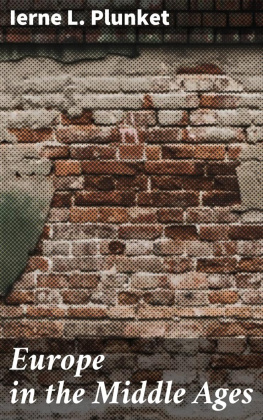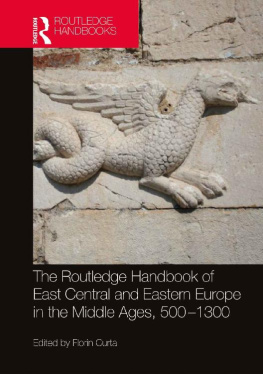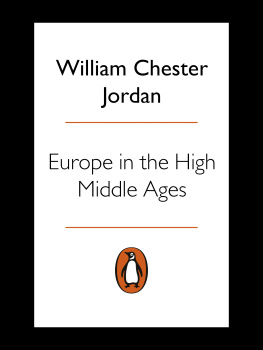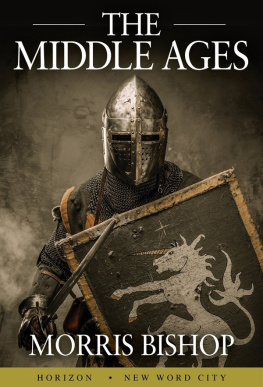PREFACE
Table of Contents
The history of Mediaeval Europe is so vast a subject that the attempt to deal with it in a small compass must entail either severe compression or what may appear at first sight reckless omission.
The path of compression has been trodden many times, as in J. H. Robinsons Introduction to the History of Western Europe, or in such series as the Periods of European History published by Messrs. Rivingtons for students, or text-books of European History published by the Clarendon Press and Messrs. Methuen.
To the authors of all these I should like to express my indebtedness both for facts and perspective, as to Mr. H. W. Davis for his admirable summary of the mediaeval outlook in the Home University Library series; but in spite of so many authorities covering the same ground, I venture to claim for the present book a pioneer path of omission; it may be reckless but yet, I believe, justifiable.
It has been my object not so much to supply students with facts as to make Mediaeval Europe live, for the many who, knowing nothing of her history, would like to know a little, in the lives of her principal heroes and villains, as well as in the tendencies of her classes, and in the beliefs and prejudices of her thinkers. This task I have found even more difficult than I had expected, for limits of space have insisted on the omission of many events and names I would have wished to include. These I have sacrificed to the hope of creating reality and arousing interest, and if I have in any way succeeded I should like to pay my thanks first of all to Mr. Henry Osborn Taylor for his two volumes of The Mediaeval Mind that have been my chief inspiration, and then to the many authors whose names and books I give elsewhere, and whose researches have enabled me to tell my tale.
IERNE L. PLUNKET.
I
THE GREATNESS OF ROME
Table of Contents
Ave, Roma Immortalis!, Hail, Immortal Rome! This cry, breaking from the lips of a race that had carried the imperial eagles from the northern shores of Europe to Asia and Africa, was no mere patriotic catchword. It was the expression of a belief that, though humanity must die and personal ambitions fade away, yet Rome herself was eternal and unconquerable, and what was wrought in her name would outlast the ages.
In the modern world it is sometimes necessary to remind people of their citizenship, but the Roman never forgot the greatness of his inheritance. When St. Paul, bound with thongs and condemned to be scourged, declared, I am Roman born, the Captain of the Guard, who had only gained his citizenship by paying a large sum of money, was afraid of the prisoner on whom he had laid hands without a trial.
To be a Roman, however apparently poor and defenceless, was to walk the earth protected by a shield that none might set aside save at great peril. Not to be a Roman, however rich and of high standing, was to pass in Roman eyes as a barbarian, a creature of altogether inferior quality and repute.
Be it thine, O Roman, says Virgil, the greatest of Latin poets, to govern the nations with thy imperial rule: and such indeed was felt by Romans to be the destiny of their race.
Stretching on the west through Spain and Gaul to the Atlantic, that vast Sea of Darkness beyond which according to popular belief the earth dropped suddenly into nothingness, the outposts of the Empire in the east looked across the plains of Mesopotamia towards Persia and the kingdoms of central Asia. Babylon the Wondrous, Syria, and Palestine with its turbulent Jewish population, Egypt, the Kingdom of the Pharaohs long ere Romulus the City-builder slew his brother, Carthage, the Queen of Mediterranean commerce, all were now Roman provinces, their lustre dimmed by a glory greater than they had ever known.
Roman Trade Routes
The Mediterranean, once the battle-ground of rival Powers, had become an imperial lake, the high road of the grain ships that sailed perpetually from Spain and Egypt to feed the central market of the world; for Rome, like England to-day, was quite unable to satisfy her population from home cornfields. The fleets that brought the necessaries of life convoyed also shiploads of oriental luxuries, silks, jewels, and perfumes, transported from Ceylon and India in trading-sloops to the shores of the Red Sea, and thence by caravans of camels to the port of Alexandria.
Other trade routes than the Mediterranean were the vast network of roads that, like the threads of a spiders web, kept every part of the Empire, however remote, in touch with the centre from which their common fate was spun. At intervals of six miles were post-houses, provided each with forty or more horses, that imperial messengers, speeding to or from the capital with important news, might dismount and mount again at the different stages, hastening on their way with undiminished speed.
How firm and well made were their roads we know to-day, when, after the lapse of nearly nineteen centuries of traffic, we use and praise them still. They hold in their strong foundations one secret of their makers greatness, that the Roman brought to his handiwork the thoroughness inspired by a vision not merely of something that should last a few years or even his lifetime, but that should endure like the city he believed eternal.
It was the boast of Augustus, 27 B.C. A.D. 14, the first of the Roman Emperors, that he had found his capital built of brick and had left it marble; and his tradition as an architect passed to his successors. There are few parts of what was once the Roman Empire that possess no trace to-day of massive aqueduct or Forum, of public baths or stately colonnades. In Rome itself, the Colosseum, the scene of many a martyrs death and gladiators struggle; elsewhere, as at Nmes in southern France, a provincial amphitheatre; the aqueduct of Segovia in Spain, the baths in England that have made and named a town; the walls that mark the outposts of empireall are the witnesses of a genius that dared to plan greatly, nor spared expense or labour in carrying out its designs.
Those who have visited the Border Country between England and Scotland know the Emperor Hadrians wall, twenty feet high by seven feet broad, constructed to keep out the fierce Picts and Scots from this the most northern of his possessions. Those of the enemy that scaled the top would find themselves faced by a ditch and further wall, bristling with spears; while the legions flashed their summons for reinforcements from guardhouse to guardhouse along the seventy miles of massive barrier. All that human labour could do had made the position impregnable.
A scheme of fortifications was also attempted in central Europe along the lines of the Rhine and Danube. These rivers provided the third of the imperial trade routes, and it is well to remember them in this connexion, for their importance as highways lasted right through Roman and mediaeval into modern times. Railways have altered the face of Europe: they have cut through her waste places and turned them into thriving centres of industry: they have looped up her mines and ports and tunnelled her mountains: there is hardly a corner of any land where they have not penetrated; and the change they have made is so vast that it is often difficult to imagine the world before their invention. In Roman times, in neighbourhoods where the sea was remote and road traffic slow and inconvenient, there only remained the earliest of all means of transport, the rivers. The Rhine and Danube, one flowing north-west, the other south-east, both neither too swift nor too sluggish for navigation, were the natural main high roads of central Europe: they were also an obvious barrier between the Empire and barbarian tribes.









